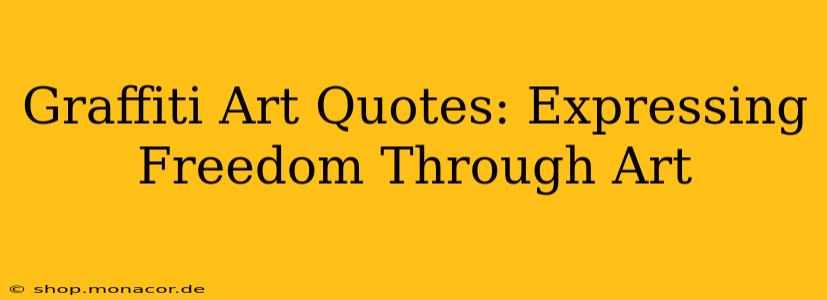Graffiti art, often misunderstood as mere vandalism, is a powerful form of self-expression, a vibrant tapestry woven with rebellion, creativity, and social commentary. It's a visual language spoken on walls, trains, and canvases, echoing the unspoken sentiments of artists and communities alike. This exploration delves into the essence of graffiti art, examining its rebellious spirit and the profound messages conveyed through impactful quotes.
What is the meaning of graffiti art?
Graffiti art's meaning is multifaceted and deeply personal to the artist. For some, it's a raw declaration of individuality, a defiant act against conformity and societal norms. Others utilize it as a political tool, a visual megaphone amplifying marginalized voices and critiques of power structures. Still others see it as a purely aesthetic pursuit, focusing on the beauty of color, composition, and form. Ultimately, the meaning of a piece of graffiti art depends on the artist's intent and the viewer's interpretation. It's a conversation starter, a visual puzzle inviting contemplation and dialogue.
How can graffiti art be considered a form of freedom of expression?
Graffiti art's inherent defiance of established norms positions it as a potent symbol of freedom of expression. By reclaiming public spaces, artists challenge the status quo and assert their right to be seen and heard. The often-illegal nature of the act further underscores its rebellious spirit, a direct confrontation with authority and a bold statement of artistic independence. This risk-taking element underscores the gravity of the message, adding weight and impact to the artist's voice. The transient nature of some graffiti, destined for eventual removal, adds another layer to the idea of freedom - a fleeting moment of visual rebellion captured before it's gone.
What are some famous graffiti quotes?
While graffiti itself is a visual form of expression, many artists embed textual elements within their work, adding depth and narrative. Pinpointing specific "famous quotes" from graffiti is challenging due to the anonymous and ephemeral nature of much of the art. However, the underlying ethos of many pieces can be summarized in powerful sentiments:
- "The walls are my canvas." This unspoken mantra reflects the artist's claim to public space as their creative domain.
- "Art is rebellion." This encapsulates the subversive nature of graffiti, a rejection of societal constraints and a demand for artistic autonomy.
- "Stay Hungry. Stay Foolish." While not strictly a graffiti quote, this Steve Jobs quote resonates deeply within the graffiti community, embodying the relentless drive and innovative spirit of many artists.
Is graffiti art vandalism or art?
The debate surrounding graffiti's classification as vandalism or art remains a contentious one. The legality of the act is certainly a factor, with unauthorized graffiti often resulting in legal consequences. However, the artistic merit of many pieces is undeniable, showcasing technical skill, creativity, and social commentary. The line blurs depending on context, location, and the intent of the artist. Some graffiti artists are commissioned for their work, transforming public spaces into vibrant and celebrated murals. This highlights the evolving perception of graffiti, transitioning from an act of defiance to a recognized artistic practice. Many city councils now actively support legal and sanctioned graffiti projects.
What are the different styles of graffiti art?
Graffiti art encompasses a broad range of styles, reflecting the diverse influences and techniques of individual artists. Some prominent styles include:
- Wildstyle: Complex, intricate lettering characterized by overlapping and interwoven letters.
- Throwups: Quickly executed, simpler letter forms typically done in bold colors.
- Stencils: Reproducible images created using stencils, allowing for mass production and consistency.
- Murals: Large-scale artworks, often collaborative, that transform entire walls into breathtaking displays of color and artistry.
These styles often blend and evolve, showcasing the ever-changing landscape of graffiti art.
Conclusion
Graffiti art is more than just colorful tags on walls; it's a powerful form of expression, a testament to human creativity and a reflection of societal attitudes. Its defiant spirit and enduring aesthetic impact continue to inspire and provoke, fueling a vibrant and ever-evolving artistic movement. Whether viewed as vandalism or art, graffiti’s capacity to convey powerful messages and challenge norms remains undeniable. The ongoing conversation surrounding its meaning and impact underscores its enduring relevance in the landscape of contemporary art.

